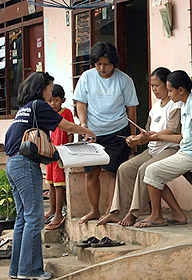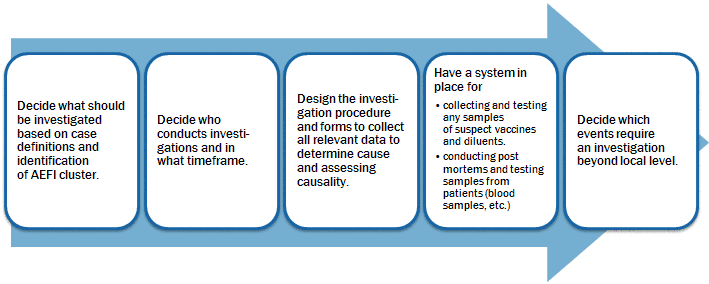Investigation
Conducting an AEFI investigation

Some AEFI reports will need further investigation. The purpose of an AEFI investigation is to:
- Confirm the diagnosis (or propose other diagnoses) and determine the outcome of the adverse event,
- Identify specifications of implicated vaccine(s) used to immunize patient(s),
- Examine operational aspects of the immunization programme, which may have led to immunization errors,
- Justify the search for other AEFI cases/clustering,
- Compare background risk of adverse event (occurring in unimmunized people) to the reported rate in the vaccinated population.
A key instrument to organize an AEFI investigation is WHO's "Aide-Memoire on AEFI Investigation". Look at the Aide-Memoire to find out more about key definitions, guidance to prepare for an investigation, as well as a checklist providing useful information for each step of an investigation. See the graphic below to view a list of practical steps that should be considered when developing AEFI investigation procedures.

AEFI reports to be investigated
Not all AEFI reports will need investigation. Reported events requiring the initiation of an investigation are:
- Serious AEFIs, i.e. adverse events or reactions that result in death, hospitalization (or prolongation of existing hospital stay), persistent or significant disability or incapacity (e.g. paralysis), or are potentially life-threatening,
- Clusters
 ClusterTwo or more instances of an event related in time, place, population subgroup, or common exposure (e.g., vaccine). AEFI clusters are usually associated with a particular provider, health facility, and/or a vial of vaccine that has been inappropriately prepared or contaminated. of minor AEFIs,
ClusterTwo or more instances of an event related in time, place, population subgroup, or common exposure (e.g., vaccine). AEFI clusters are usually associated with a particular provider, health facility, and/or a vial of vaccine that has been inappropriately prepared or contaminated. of minor AEFIs, - Signals
 SignalReported information on a possible causal relationship between an adverse event and a drug, the relationship being previously unknown or incompletely documented. Usually more than a single report is required to generate a signal, depending upon the seriousness of the event and the quality of the information. and events associated with newly introduced vaccines,
SignalReported information on a possible causal relationship between an adverse event and a drug, the relationship being previously unknown or incompletely documented. Usually more than a single report is required to generate a signal, depending upon the seriousness of the event and the quality of the information. and events associated with newly introduced vaccines, - Other AEFIs as recommended by WHO:
- AEFIs that may have been caused by immunization error (e.g. bacterial abscess, severe local reaction, high fever or sepsis, BCG lymphadenitis
 LymphadenitisLymphadenitis is the inflammation and/or enlargement of one or more lymph nodes. Most cases indicate an immune response in the node to local infection or antigen stimulation, for example in a vaccine. Generalised lymphadenitis is a widespread inflammation of the lymph nodes due to systemic (circulating) infection., toxic shock syndrome
LymphadenitisLymphadenitis is the inflammation and/or enlargement of one or more lymph nodes. Most cases indicate an immune response in the node to local infection or antigen stimulation, for example in a vaccine. Generalised lymphadenitis is a widespread inflammation of the lymph nodes due to systemic (circulating) infection., toxic shock syndrome Toxic shock syndromeA rare serious adverse event resulting from improper vaccine preparation and injection practices. It is a life-threatening illness that is caused by toxins (poisons) that circulate in the bloodstream. Bacteria that have infected some part of the body release these toxins. People with toxic shock syndrome develop high fever, rash, low blood pressure, and failure of multiple organ systems in the body., clusters of AEFIs),
Toxic shock syndromeA rare serious adverse event resulting from improper vaccine preparation and injection practices. It is a life-threatening illness that is caused by toxins (poisons) that circulate in the bloodstream. Bacteria that have infected some part of the body release these toxins. People with toxic shock syndrome develop high fever, rash, low blood pressure, and failure of multiple organ systems in the body., clusters of AEFIs), - Significant events of unexplained cause occurring within 30 days after a vaccination,
- Events causing significant parental or community concern.
- AEFIs that may have been caused by immunization error (e.g. bacterial abscess, severe local reaction, high fever or sepsis, BCG lymphadenitis
AEFI cluster investigations
A cluster of AEFI is defined as two or more cases of the same adverse event related in time, place or the vaccine administrated. Apart from checking on these three factors (e.g. checking vaccine batch), the investigator should check for AEFIs occurring in similar age groups and populations with genetic predisposition or disease.
Cluster investigation begins by establishing the case definition and identifying all cases that meet the case definition. The immunization programme manager should then take two actions.
- Identify the immunization history of the cluster cases including details of when, where and which vaccines were given, by collecting and recording:
- Detailed data on each patient,
- Programme-related data (storage and handling, etc.),
- Immunization practices and the associated health workers' practices.
- Identify any common exposures among the cases, for example:
- All data on vaccine(s) used (name, lot number, etc.),
- Data on other people in the area (also non-exposed).
Including vaccine testing in an AEFI investigation
If it is appropriate to the working hypothesis on the possible cause of the vaccine reaction, collecting and testing a vaccine specimen may confirm or rule out a suspected vaccine-associated cause of the AEFI.
For vaccine testing, collect a vial of the residual vaccine (if possible) from the health facility. Retain adequate samples from the same site of unopened vaccine and diluent vials if the vaccine was reconstituted. The samples should be maintained under correct storage conditions until a decision on testing is made.
If a vaccine is implicated in an AEFI case or cluster, it is rarely necessary to test the vaccine quality, which should already be part of the national regulatory protocols. Potency![]() PotencyA measure of strength or immunogenicity in vaccines. testing is of little value and is only useful to determine reasons for lack of vaccine efficacy.
PotencyA measure of strength or immunogenicity in vaccines. testing is of little value and is only useful to determine reasons for lack of vaccine efficacy.
If a decision is made to test the vaccine (and where appropriate, the diluent), the test(s) chosen depend on the nature of the adverse event and the working hypotheses on the possible causes. One or more of the following tests may be carried out:
- Visual test for clarity, presence of foreign matter, turbulence or discoloration,
- Sterility testing (vaccine and/or injection equipment) if an infectious cause is suspected,
- Chemical composition analysis: preservatives, adjuvant level, etc. (e.g. aluminium content); abnormal components (e.g. suspect drug used instead of vaccine or diluent),
- Biological tests for foreign substances or toxins if abnormal toxicity is suspected (note: OPV-neurovirulence testing is expensive and adequate samples are not usually available),
- Additional field performance information should be obtained from the vaccine manufacturer.

